
 |
Deafness & Judaism On Stamps
By Kenneth S. Rothschild
[This article originally appeared in the October 2006 issue of The Israel Philatelist, and is reprinted here with Ken's permission.]
As a diehard philatelist for more than 40 years, I started out small with USA stamps in various formats. I evolved into United Nations stamps because it was near where I grew up in the Bronx — the home of the famous World Champion New York Yankees. (Any Bronx cheers respectfully declined!)
I later added Scouting on stamps because I was a Boy Scout, and then when President Kennedy was assassinated, I fell into the Kennedy stamp collecting craze. That fad eventually wore out. Canada was a neighbor, so I went into Canadian stamps.
As a Jewish boy, I always had a strong desire to be identified as one — I still do — and I eventually went into Israeli stamps and am now a proud Life Member of the Society of Israel Philatelists. As the USA, UN, Canadian, and Israel stamps became routine over the years with simple collecting and no challenges involved, I delved into the deaf topic subject because, yes, you guessed it by now, I am deaf.
Deaf Topic Area
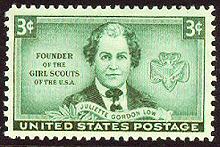 This is a very challenging topic area, as only a few philatelists are into this topic and I am considered the world's foremost expert on it. I have given presentations, written articles, and been interviewed (both for print and video media) on this topic. You may jump at the fact that it could be simple by just collecting stamps dealing with Ludwig von Beethoven, Thomas Alva Edison, Konstantin Eduardovich Tsiolkovsky, Juliette Gordon Low (picture, right), and Francisco de Goya — all of whom had hearing loss.
This is a very challenging topic area, as only a few philatelists are into this topic and I am considered the world's foremost expert on it. I have given presentations, written articles, and been interviewed (both for print and video media) on this topic. You may jump at the fact that it could be simple by just collecting stamps dealing with Ludwig von Beethoven, Thomas Alva Edison, Konstantin Eduardovich Tsiolkovsky, Juliette Gordon Low (picture, right), and Francisco de Goya — all of whom had hearing loss.
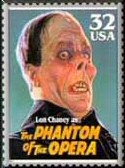 Other notables such as Lon Chaney (son of deaf parents) and his son, Lon Chaney, Jr. (U.S. Sc. 2822, #3168, and #3172 , plus the last two designs also in postal card formats, and Sierra Leone Sc. 2034a & b), Alexander Graham Bell (teacher of the deaf, son of a deaf mother and husband of a deaf wife), Helen Adams Keller, Samuel Finley Breeze Morse (his second wife was deaf and he communicated with her by tapping on her hands just like his Morse Code) had various philatelic commemorations.
Other notables such as Lon Chaney (son of deaf parents) and his son, Lon Chaney, Jr. (U.S. Sc. 2822, #3168, and #3172 , plus the last two designs also in postal card formats, and Sierra Leone Sc. 2034a & b), Alexander Graham Bell (teacher of the deaf, son of a deaf mother and husband of a deaf wife), Helen Adams Keller, Samuel Finley Breeze Morse (his second wife was deaf and he communicated with her by tapping on her hands just like his Morse Code) had various philatelic commemorations.
Aside from the above well-known deaf-related personages, there are better and more interesting philatelic items out there to recognize the real deaf subject. These include areas such as hearing loss and hearing aids, Nobel Prize winners/otologists, persons who worked with the deaf, founders of schools for the deaf, deaf school anniversaries, deaf conferences, deaf sporting events, and so on.
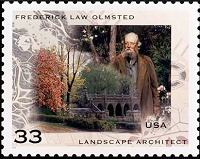 An indirect example is the 1999 Frederick Law Olmsted stamp (Sc. 3338), where he is recognized for the design of New York City's Central Park. It is little known that he also designed the campus on which Gallaudet University, the world's only foremost institution of higher education for the Deaf, is situated in northeast Washington, D.C.
An indirect example is the 1999 Frederick Law Olmsted stamp (Sc. 3338), where he is recognized for the design of New York City's Central Park. It is little known that he also designed the campus on which Gallaudet University, the world's only foremost institution of higher education for the Deaf, is situated in northeast Washington, D.C.
While the Jewish philatelic subject area is limited, compounding it further with the smaller deaf philatelic subject gives us a smaller subject to discuss. Dr. Isaac Shubich's August 2002 article in the Ear, Nose & Throat Journal that is entitled "Philately and Otolaryngology - Special Feature" further reinforces this fact:
The included examples represent one of many possible medical themes in stamp collecting. Compared with stamps related to cardiology, ophthalmology and other specialties, examples related to otolaryngology are still relatively few (despite the many contributions to medicine from our specialty, important personalities from ENT history are not often placed in postal emissions).Deaf Education
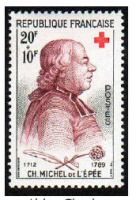 Everybody's major upbringing has always been based in education. Without it, what would each one of us be? Deaf education had its roots with the first formal education established in Paris. Abbé Charles Michel de l'Épeé (1712-1789) founded the "Institution Nationale des sourdsmuets de Paris," which translates as the "National Deaf-Dumb Institute of Paris." He is honored on a 1959 French semi-postal stamp (Sc. B337).
Everybody's major upbringing has always been based in education. Without it, what would each one of us be? Deaf education had its roots with the first formal education established in Paris. Abbé Charles Michel de l'Épeé (1712-1789) founded the "Institution Nationale des sourdsmuets de Paris," which translates as the "National Deaf-Dumb Institute of Paris." He is honored on a 1959 French semi-postal stamp (Sc. B337).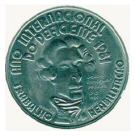 However, sign language and the roots of deaf education are traced back to a Jewish person from Portugal. Jacob Rodrigues Pereira (1715-1780) is credited with being the first person to teach a deaf-mute to speak. There was no stamp issued to honor him, but Portugal honored Pereira with a 100-Escudo coin during the 1981 International Year of Disabled Persons (IYDP).
However, sign language and the roots of deaf education are traced back to a Jewish person from Portugal. Jacob Rodrigues Pereira (1715-1780) is credited with being the first person to teach a deaf-mute to speak. There was no stamp issued to honor him, but Portugal honored Pereira with a 100-Escudo coin during the 1981 International Year of Disabled Persons (IYDP).Otology
As a Jewish deaf person, it is my pleasure to lead you, the readers, through this article, which will focus on The Deaf Subject in Judaic Philately, and I will start off with the otology area.
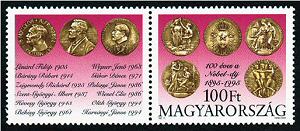
Robert Bárány, a Jewish person, won the 1914 Nobel Prize in Medicine/Physiology. His award was made "for his work on the physiology and pathology of the vestibular apparatus." In laymen's terms, he researched the balancing system of the inner ear. Bárány completed his medical studies at Vienna University in 1900.
He was an assistant of Adam Politzer (see below) and was honored on several postage stamps from several countries: Hungary (Sc. 3155 and Sc. 3514), Austria (Sc. 1031), Chad (Sc. 719 and a souvenir sheet), Sweden (Sc. 1105) and St. Vincent and the Grenadines (Sc. 2220a). Bárány was born in Vienna, Austria, on April 22, 1876 and died on April 8, 1936 in Uppsala, Sweden.
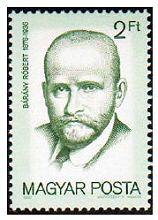
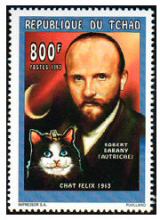
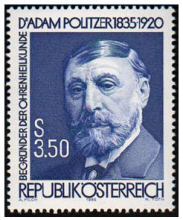 Adam Politzer, another Jewish person, was honored on a stamp from Austria (Sc. 1326). Politzer was born on October 1, 1835 in Alberti (now Albertirsa), Hungary, into a well-to-do Jewish family. He studied medicine in Vienna and became a doctor in 1859. He went on to work with Hermann von Helmholtz in Heidelberg and then his student Rudolf Körni in Paris to improve his knowledge of auditory physiology. His studies in Paris were completed by his contacts with Claude Bernard of The College of France and Prospere Meniere of the Deaf and Dumb Institute of Paris.
Adam Politzer, another Jewish person, was honored on a stamp from Austria (Sc. 1326). Politzer was born on October 1, 1835 in Alberti (now Albertirsa), Hungary, into a well-to-do Jewish family. He studied medicine in Vienna and became a doctor in 1859. He went on to work with Hermann von Helmholtz in Heidelberg and then his student Rudolf Körni in Paris to improve his knowledge of auditory physiology. His studies in Paris were completed by his contacts with Claude Bernard of The College of France and Prospere Meniere of the Deaf and Dumb Institute of Paris.Finally, he went to London to study ear pathology under Josef Toynbee. When Politzer returned to Vienna in 1861, he became the first teacher of otology. With two other men in 1864, he published the first journal to cover only pathologic conditions of the ear, Archiv für Ohrenheilkunde. In 1871, he became the extraordinary professor of otology at Vienna University. Politzer and Josef Gruber became co-directors of the Otologic Clinic in Vienna, which was founded in 1873, the first establishment of its kind in the world. In 1894, Politzer was the professor of otology before retiring in 1907. He died on August 10, 1920.
Israeli Issues
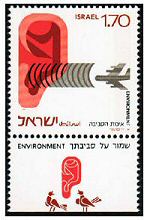
The December 9, 1975 Environmental Protection three-stamp set was issued to pay attention to different pollution issues. The IL 1.70 pound stamp (Sc. 582) pays attention to noise pollution; it shows an ear bearing the noise generated by a jet.
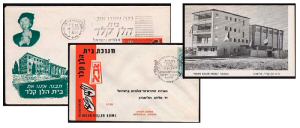 The June 1, 1956 cover promoted the idea of building a community center for the deaf in Israel. Even though Helen Keller was deaf-blind, this home catered mainly to the deaf populace. The completion of this home was commemorated on the January 8, 1958 cover. The two sign language hand shapes in both the cachet design and the cancel portray (from top to bottom) the letters "H" and "K." The home is photographed on the back side of a 60-agora postal card. This story does not end here, as this center also housed offices of various organizations such as the Sport Organization of the Deaf in Israel and the World Organization of Jewish Deaf.
The June 1, 1956 cover promoted the idea of building a community center for the deaf in Israel. Even though Helen Keller was deaf-blind, this home catered mainly to the deaf populace. The completion of this home was commemorated on the January 8, 1958 cover. The two sign language hand shapes in both the cachet design and the cancel portray (from top to bottom) the letters "H" and "K." The home is photographed on the back side of a 60-agora postal card. This story does not end here, as this center also housed offices of various organizations such as the Sport Organization of the Deaf in Israel and the World Organization of Jewish Deaf.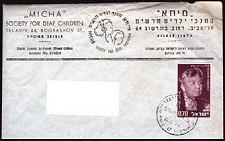
A 1964 postmarked envelope is shown here as a representative example of another organization in Israel, "Micha." that helps Deaf children.
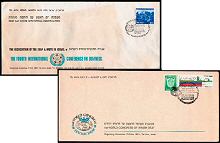 Israel provided two special pictorial cancels for two major international deaf events held in Israel. The March 19, 1973, cancel was for the 1973 Fourth International Conference on Deafness, which was held under the auspices of the World Federation of the Deaf, as shown by their logo on the cachet and in the postmark cancel. The August 1, 1977 cancel was for the 1977 First World Congress of Jewish Deaf Conference.
Israel provided two special pictorial cancels for two major international deaf events held in Israel. The March 19, 1973, cancel was for the 1973 Fourth International Conference on Deafness, which was held under the auspices of the World Federation of the Deaf, as shown by their logo on the cachet and in the postmark cancel. The August 1, 1977 cancel was for the 1977 First World Congress of Jewish Deaf Conference.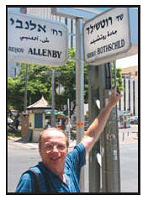
On my recent summer 2006 trip to Israel, I had the opportunity to stop by at the office of BEKOL, the Organization of Hard of Hearing & Deafened People in Tel Aviv. I was able to get their inland postal stationery envelope imprinted with the organization's name.
Other Countries: Brazil
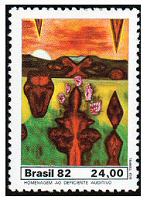 The following is taken verbatim, with the addition of Scott catalog numbers, from the January-February, 1996 issue of the Jewish Deaf Community Center Newsletter, in which I detailed the 1982 "Homage to the Deaf" stamp from Brazil (Sc. 1836).
The following is taken verbatim, with the addition of Scott catalog numbers, from the January-February, 1996 issue of the Jewish Deaf Community Center Newsletter, in which I detailed the 1982 "Homage to the Deaf" stamp from Brazil (Sc. 1836).Sigi Tempel, a Brazilian Jew from Sao Paulo, was born in Leipzig in 1921, the son of an Orthodox Jewish family. At the age of 17, with the help of the "Joint," he left Nazi Germany for Rio de Janeiro where, five years later, he became a designer for an industry. He soon began to express his mystic visions in oil paintings, and his concern about ethics and morality began to show themselves in his art when he found that in the grain of wood he could express his feelings, ideology and thoughts. In the National Year of the Disabled, he painted "EFETA" as homage to the deaf mutes of the world, and this painting was purchased by UNESCO and has now been reproduced by the Brazilian Postal Authorities, on a postage stamp. He is married with three children and believes in upholding his Jewish tradition and background.
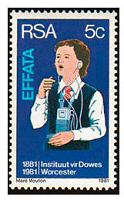 According to my research, the 1981 South Africa stamp (Sc. 550), celebrating the 100th Anniversary of the Institute for the Deaf and Blind in Worcester, has an EFFATA motto on the stamp. This is because it is the institute's motto. It is the Aramaic word used by Jesus Christ, according to Mark 7:34, in the healing of a deaf-mute that means "be opened." Since Brazil's language is Portuguese, it is obviously inferred that EFETA is the same as the EFFATA quote, especially when the South African and the Brazilian stamps are about the Deaf subject. The "T" finger-spelling sign is different because we understand that our American "T" finger-spelling sign is offensive in some other countries, thus these countries finger-spell the "T" letter differently.
According to my research, the 1981 South Africa stamp (Sc. 550), celebrating the 100th Anniversary of the Institute for the Deaf and Blind in Worcester, has an EFFATA motto on the stamp. This is because it is the institute's motto. It is the Aramaic word used by Jesus Christ, according to Mark 7:34, in the healing of a deaf-mute that means "be opened." Since Brazil's language is Portuguese, it is obviously inferred that EFETA is the same as the EFFATA quote, especially when the South African and the Brazilian stamps are about the Deaf subject. The "T" finger-spelling sign is different because we understand that our American "T" finger-spelling sign is offensive in some other countries, thus these countries finger-spell the "T" letter differently.United States
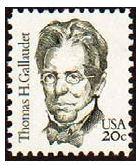 I had major roles in two United States Deaf-related stamp issues. The first one, the Thomas H. Gallaudet 20˘ stamp (Sc. 1861) was issued on June 10, 1983, on the grounds of American School for the Deaf in West Hartford, Conn. Gallaudet founded this first school for the deaf in America after traveling abroad to find suitable teaching methods for the deaf, and he focused on the Paris school.
I had major roles in two United States Deaf-related stamp issues. The first one, the Thomas H. Gallaudet 20˘ stamp (Sc. 1861) was issued on June 10, 1983, on the grounds of American School for the Deaf in West Hartford, Conn. Gallaudet founded this first school for the deaf in America after traveling abroad to find suitable teaching methods for the deaf, and he focused on the Paris school.Other schools for the deaf from all over the world got their beginnings from Paris as well. I led the drive to have this stamp issued on behalf of my alma mater, Gallaudet College (it became a University in 1986). This world-famed institution was established in 1864 to provide Deaf people an opportunity for collegelevel education in sign language.
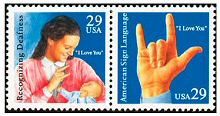 Fast-forward 10 years later: I took the lead on behalf of the National Association of the Deaf to have the Recognizing Deafness / American Sign Language Deaf Communication 29˘ se-tenant stamps (Sc. 2783-4) issued in Burbank, Calif., during the annual Deaf Awareness Week (the last full week in September). With my heavy involvement in this stamp issuance, I can safely inform you that the mother/baby stamp design was taken from an actual photograph and subsequently altered to hide the facial features. The original picture, photographed by a Jewish deaf father, shows his deaf wife and their newborn deaf son.
Fast-forward 10 years later: I took the lead on behalf of the National Association of the Deaf to have the Recognizing Deafness / American Sign Language Deaf Communication 29˘ se-tenant stamps (Sc. 2783-4) issued in Burbank, Calif., during the annual Deaf Awareness Week (the last full week in September). With my heavy involvement in this stamp issuance, I can safely inform you that the mother/baby stamp design was taken from an actual photograph and subsequently altered to hide the facial features. The original picture, photographed by a Jewish deaf father, shows his deaf wife and their newborn deaf son.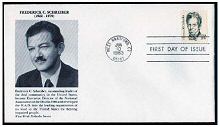 Being involved in each of the above two American stamp issues, I was instrumental in providing ideas to the B'nai B'rith Philatelic Service on appropriate FDC cachet design tie-ins. Frederick Schreiber was an outstanding leader of the deaf community in the United States and was the first executive director of the National Association of the Deaf in 1968 until his untimely death in 1979.
Being involved in each of the above two American stamp issues, I was instrumental in providing ideas to the B'nai B'rith Philatelic Service on appropriate FDC cachet design tie-ins. Frederick Schreiber was an outstanding leader of the deaf community in the United States and was the first executive director of the National Association of the Deaf in 1968 until his untimely death in 1979.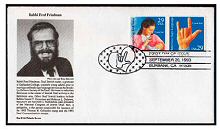 Rabbi Fred Friedman is pictured on the other cachet as one of the deaf Jewish leaders in the United States deaf community. He and his wife, Connie, are very active in the Jewish Orthodox deaf community. The descriptive insert also goes on to mention Rabbi Daniel T. Grossman and Rabbi Rebecca Dubowe as well as myself, Kenneth S. Rothschild.
Rabbi Fred Friedman is pictured on the other cachet as one of the deaf Jewish leaders in the United States deaf community. He and his wife, Connie, are very active in the Jewish Orthodox deaf community. The descriptive insert also goes on to mention Rabbi Daniel T. Grossman and Rabbi Rebecca Dubowe as well as myself, Kenneth S. Rothschild.If there are any comments to help me out further in my philatelic research, please feel free to contact me.
Acknowledgments: E-mail correspondence were greatly appreciated with Dr. Isaac Shubich of Miami, Florida in granting permission to use the excerpt from his article and with Dr. Albert Mudry of Lausanne, Switzerland for verification and excerpts of Dr. Robert Bárány's and Dr. Adam Politzer's biographical information. Also thanks to the Jewish Deaf Community Center for the excerpt permission.